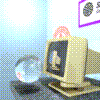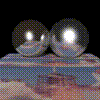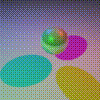CS 348B 1992 Rendering Competition
CS 348B - Computer Graphics: Image Synthesis Techniques
Winter quarter, 1992
Instructor: Marc Levoy
Teaching assistant: Brian Curless
Press here for a general introduction to these
rendering competitions.
Monitor Scene by Steve Newman
 Steve's monitor scene was the winner of "render-off" for a best rendering of a
scene containing an SGI monitor. Steve modeled the scene using his own CSG
(Constructive Solid Geometry) modeler. The seat, table, and wall textures were
procedurally generated, and the cover of the book (the textbook for the course,
An Introduction to Ray Tracing, edited by Andrew Glassner) was scanned in using
the course scanner. The translucent ball models the refraction of light
through a glass sphere.
Steve's monitor scene was the winner of "render-off" for a best rendering of a
scene containing an SGI monitor. Steve modeled the scene using his own CSG
(Constructive Solid Geometry) modeler. The seat, table, and wall textures were
procedurally generated, and the cover of the book (the textbook for the course,
An Introduction to Ray Tracing, edited by Andrew Glassner) was scanned in using
the course scanner. The translucent ball models the refraction of light
through a glass sphere.
Monitor Scene by Steve Woo
 A runner-up in the "render-off", Steve assembled his scene using the modeler
and scene composer provided for the course. The poster and desktop textures
were scanned in with the course scanner. The image on the monitor's curved
screen is a texture-mapped image of the monitor itself. The translucent ball
models the refraction of light through a glass sphere.
A runner-up in the "render-off", Steve assembled his scene using the modeler
and scene composer provided for the course. The poster and desktop textures
were scanned in with the course scanner. The image on the monitor's curved
screen is a texture-mapped image of the monitor itself. The translucent ball
models the refraction of light through a glass sphere.
Shuttle Balls by Eric Bosco and Deepa Francis
 The metal balls sit atop a surface texture-mapped with a slide strip of a
shuttle take-off (a tiff image obtained from the Internet). Notice that the
ball on the left is perfectly reflective, while the other has an abraded
appearance. They achieved this effect by casting multiple rays off of the
surface of the ball in directions close to the angle of perfect reflection.
The average result of these rays is a blurring of the reflected image.
The metal balls sit atop a surface texture-mapped with a slide strip of a
shuttle take-off (a tiff image obtained from the Internet). Notice that the
ball on the left is perfectly reflective, while the other has an abraded
appearance. They achieved this effect by casting multiple rays off of the
surface of the ball in directions close to the angle of perfect reflection.
The average result of these rays is a blurring of the reflected image.
Chess Set by Robert Tobler
 Robert modeled this scene using his own CSG (Constructive Solid Geometry)
modeler. Note the translucency and refractiveness of the chess pieces as well
as the reflectiveness of the metallic squares on the chessboard.
Robert modeled this scene using his own CSG (Constructive Solid Geometry)
modeler. Note the translucency and refractiveness of the chess pieces as well
as the reflectiveness of the metallic squares on the chessboard.
Three Spots by Anne Eagle and Chet Erez
 This simple scene neatly demonstrates the idea of subtractive colors. The steel
ball is suspended above a white plane and illuminated by red, green, and blue
point light sources. Where the light sources are all unoccluded, their colors
mix on the plane in proportion to their distances from the plane. On the other
hand, the shadows indicate a mixture of only two colors, since one of the light
sources is occluded. The results are cyan, magenta, and yellow, the complements
of red, green and blue, respectively. Note that these are the same subtractive
colors used in printing technology.
This simple scene neatly demonstrates the idea of subtractive colors. The steel
ball is suspended above a white plane and illuminated by red, green, and blue
point light sources. Where the light sources are all unoccluded, their colors
mix on the plane in proportion to their distances from the plane. On the other
hand, the shadows indicate a mixture of only two colors, since one of the light
sources is occluded. The results are cyan, magenta, and yellow, the complements
of red, green and blue, respectively. Note that these are the same subtractive
colors used in printing technology.
Last update: July 19, 1994
[email protected]